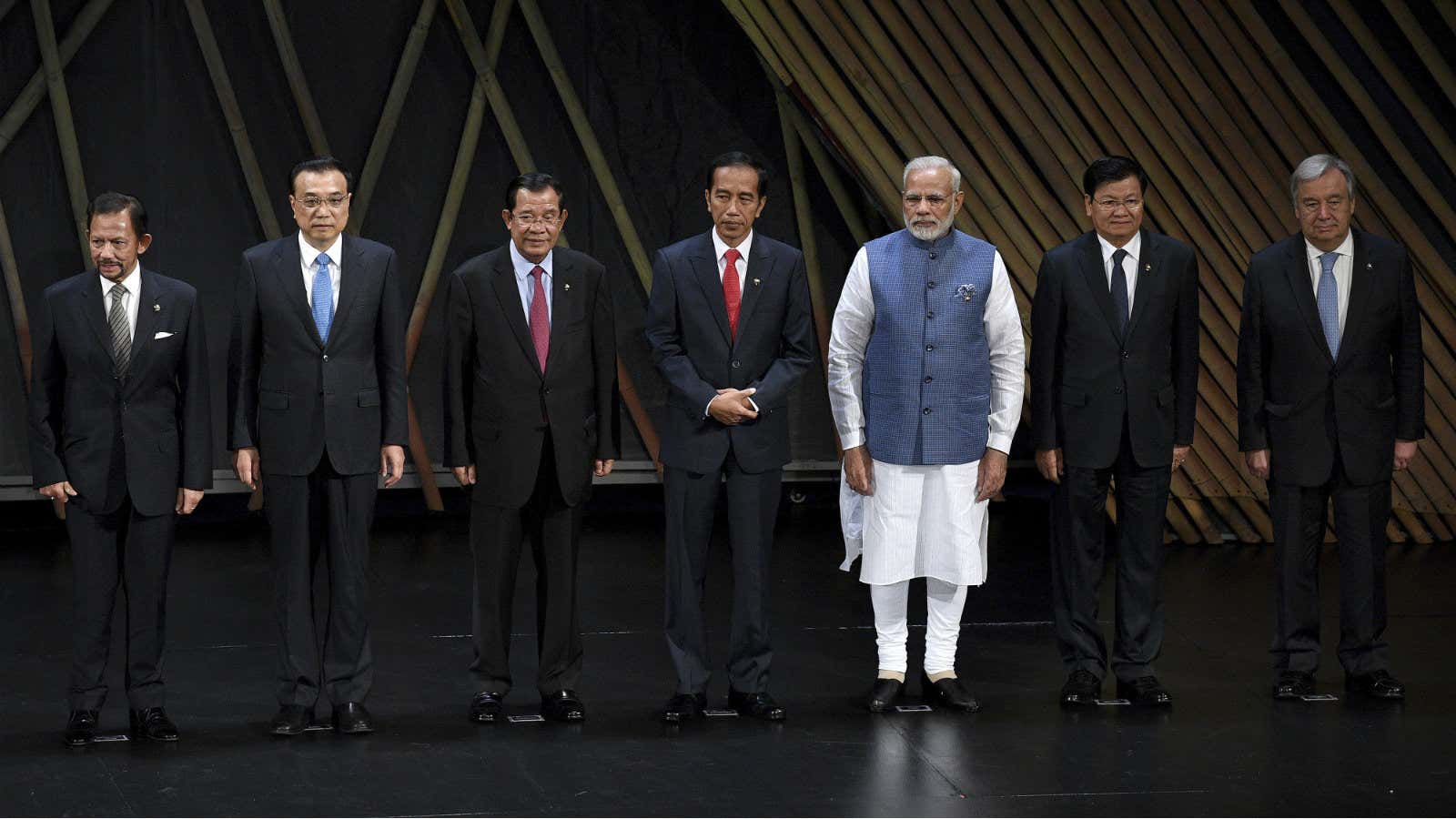Leaders of the Association of South-East Asian Nations (ASEAN) are chief guests at India’s Republic Day celebrations in New Delhi today (Jan. 26). Prime minister Narendra Modi hopes the warmth of his embrace will win him friends in a region dominated by China.
But even before this outreach, Modi has fared well in southeast Asia.
In fact, he has to thank the people of ASEAN for being ranked the third most-popular world leader by a Gallup International Association (GIA) survey in collaboration with CVoter International, released in January 2018.
While, in the last two years, Modi’s popularity has seen marginal improvements in the US, UK, and Japan, it has slipped in France and Germany. The net rating in south Asian countries has fallen, but Modi received the biggest boost from Vietnam, followed by Indonesia and the Philippines.
In all, Modi’s global ratings were up by a net four points, thanks to a 26-point boost from the ASEAN.
Modi’s ‘Pho’pularity
Of all southeast Asian countries he has visited, the Indian prime minister seems to have left the maximum impact on Vietnam in 2016, which alone gave a 62-point kick in his favour.
Hanoi’s affection for Modi may have stemmed from its need to counter the neighbourhood bully, China. Modi struck the right chord when, in November 2017, he told an ASEAN summit in Manila that India advocated the settlement of disputes (in the South China Sea) via peaceful means and as per international law. This is not something China likes to hear; it wants to settle the issue bilaterally.
Like Vietnam, India also has territorial disputes with China, and the recent flare up in the Doklam Valley tested both sides. That aside, China’s strategy to encircle India using its own south Asian neighbours, Pakistan, Nepal, Sri Lanka, and the Maldives has led to serious apprehensions in New Delhi.
India’s shared concerns with the likes of Vietnam received a nod from the US, which acknowledged the “Indo-Pacific”—and not just “Asia-Pacific”—as a geographic framework for strategic cooperation. ”The term Indo-Pacific has now gained currency, suggesting that the region spanning the Indian and the Pacific oceans is now being viewed organically as one in security terms. The India dimension is prominent in the new formulation, unlike in the term, Asia-Pacific,” former Indian foreign secretary Kanwal Sibal wrote in the Telegraph recently.
Medicines and pickups
Modi is yet to visit Indonesia but has already gained a fan base there. Meanwhile, Indonesian president Joko Widodo is set to make his second trip to India in about a year. The two countries deepened their defence ties in December 2016. Widodo drew parallels between India and Indonesia as victims of terrorism and the need to work together to combat extremists.
The Philippines, on the other hand, wants inexpensive medicines from India. President Rodrigo Duterte has invited Indian drug makers to set up facilities in his country. However, it’s not just about cheap medicines.
In November 2017, the two countries signed four agreements in defence, logistics, agriculture, and micro, small, and medium enterprises. The Philippine National Police uses Mahindra cars.
Enter America
Even as the southeast Asian economies look to find a deal with China’s domination, the US pulling out of the Trans-Pacific Partnership (TPP) has come as a body blow for them.
“(The ASEAN countries) have become increasingly vulnerable to any economic shocks that could impact upon the Chinese economy in the future. The old adage that ‘when the US sneezes, the world catches a cold’ also can now be rephrased as ‘when China sneezes, Asia catches influenza’,” said Rajiv Biswas, senior director and chief Asia-Pacific economist at consultancy firm IHS Markit.
The ASEAN has a trade deficit of $77 billion with China and a trade surplus of over $45 billion with the US, according to ASEAN data from November 2016 (pdf). The TPP was meant to be a counter to China’s economic hegemony in the southeast Asia, but the US put paid to the plans.
Meanwhile, India-ASEAN bilateral trade reached $71 billion in 2016-17, constituting around 10% of India’s total global trade, according to IHS Markit. The firm sees the potential to at least double this number to around $140 billion by 2025.
“Strategically India should give the highest priority to strengthening its relationship with ASEAN, which will be one of the world’s most dynamic and fast-growing regions over the next 20 years,” Biswas said.
Between the shared apprehension towards China (political and economic) and the potential for economic benefits, there is a lot working for the Indo-ASEAN relationship. Modi may be the face of it.
Correction: This post previously mentioned that Modi’s ratings had sharply dropped in the UK, US and Japan. The Indian prime minister’s ratings have actually marginally risen in those countries.
